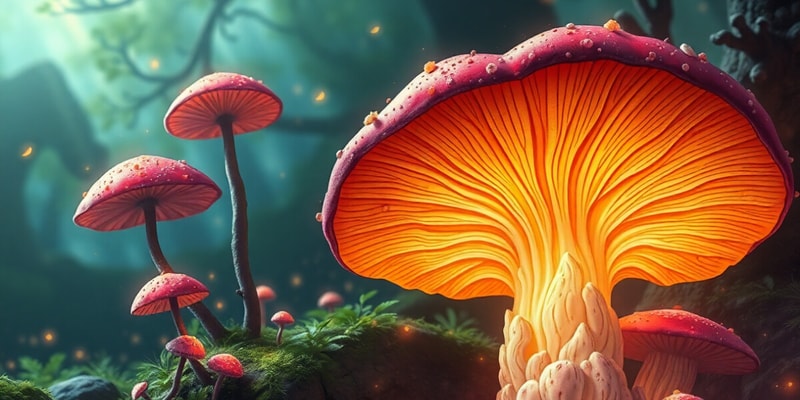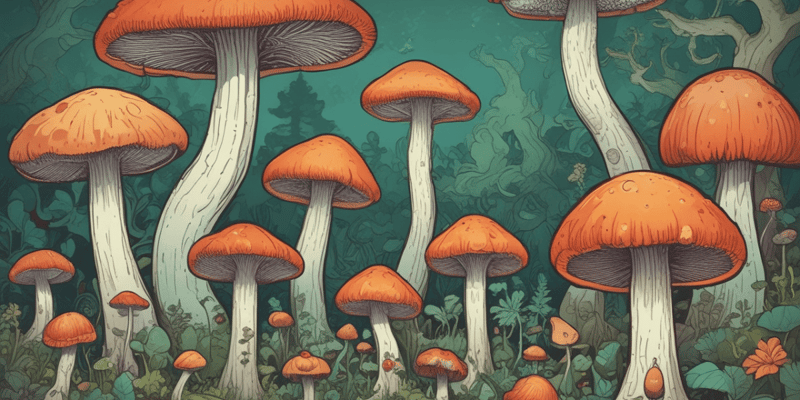Podcast Beta
Questions and Answers
What is the primary component of fungal cell walls?
Which type of fungi is known for its filamentous structures called hyphae?
What role do fungi play in the ecosystem as decomposers?
Which of the following fungi is commonly used in the food industry for fermentation?
Signup and view all the answers
Which type of reproduction involves the combination of genetic material from two different mating types in fungi?
Signup and view all the answers
Which of the following represents a symbiotic relationship involving fungi?
Signup and view all the answers
Why are fungal infections particularly concerning for immunocompromised individuals?
Signup and view all the answers
Which of the following challenges is associated with the study of mycology?
Signup and view all the answers
Which statement accurately describes the primary difference between prokaryotic and eukaryotic microorganisms?
Signup and view all the answers
What is the primary method of reproduction in bacteria?
Signup and view all the answers
Which of the following characteristics is typical of archaea?
Signup and view all the answers
How do viruses differ fundamentally from bacteria?
Signup and view all the answers
Which group of microorganisms is primarily heterotrophic and often motile?
Signup and view all the answers
Which application of microorganisms actively aims to restore environmental health?
Signup and view all the answers
In what type of environment are archaea most commonly found?
Signup and view all the answers
Which of the following is a major role that fungi play in nutrient cycling?
Signup and view all the answers
Study Notes
Microorganisms: Mycology
Definition
- Mycology is the study of fungi, a diverse group of eukaryotic organisms.
Fungi Characteristics
- Eukaryotic cells: Have a defined nucleus and membrane-bound organelles.
- Unicellular or multicellular: Includes yeasts (unicellular) and molds (multicellular).
- Cell wall composition: Primarily made of chitin, unlike plants (cellulose).
- Heterotrophic: Obtain nutrients through absorption; decompose organic matter.
Types of Fungi
-
Yeasts
- Unicellular fungi.
- Reproduce asexually by budding or fission.
- Example: Saccharomyces cerevisiae (baker’s yeast).
-
Molds
- Multicellular fungi with filamentous structures called hyphae.
- Hyphae can form a network called mycelium.
- Example: Penicillium (used in antibiotic production).
-
Fleshy Fungi
- Macroscopic fungi, including mushrooms.
- Have fruiting bodies (e.g., spores for reproduction).
- Example: Agaricus bisporus (common mushroom).
Fungal Reproduction
- Asexual reproduction: Through spores and budding.
- Sexual reproduction: Involves the combination of genetic material from two different mating types.
Ecological Role
- Decomposers: Break down dead organic matter, recycling nutrients.
- Symbiotic relationships:
- Mycorrhizae: Associations with plant roots, enhancing nutrient uptake.
- Lichens: Symbiotic relationship between fungi and algae or cyanobacteria.
Importance in Human Life
- Medical uses: Antibiotics (e.g., penicillin from Penicillium) and antifungals.
- Food industry: Fermentation in bread, beer, and cheese production.
- Biotechnological applications: Production of enzymes, biofuels, and pharmaceuticals.
Pathogenic Fungi
- Can cause diseases in plants (e.g., rusts, smuts) and animals, including humans (e.g., candidiasis, ringworm).
- Fungal infections are often opportunistic, affecting immunocompromised individuals.
Research Areas
- Fungal genetics: Understanding gene function and regulation.
- Mycoremediation: Using fungi to degrade environmental pollutants.
- Fungal biodiversity: Documenting and studying various fungal species and their roles in ecosystems.
Challenges in Mycology
- Identification and classification: Fungi can be difficult to study due to their vast diversity.
- Antibiotic resistance: Increased resistance in pathogenic fungi poses a public health threat.
Mycology: The Study of Fungi
- Mycology delves into the fascinating world of fungi, a diverse group of eukaryotic organisms.
- Fungi exhibit a unique combination of characteristics, setting them apart from other kingdoms.
Fungal Characteristics
- Fungi are eukaryotic, meaning they possess a defined nucleus and membrane-bound organelles.
- They exist in both unicellular and multicellular forms, with yeasts representing the unicellular type and molds representing multicellular types.
- Unlike plants that use cellulose, fungi have cell walls primarily composed of chitin, a tough and durable polysaccharide.
- Fungi thrive as heterotrophs, obtaining essential nutrients through absorption. They play an important role in decomposing organic matter, recycling nutrients back into the ecosystem.
Types of Fungi
-
Yeasts: Unicellular fungi, responsible for fermentation in various food products.
- Reproduce asexually through budding or fission.
- A familiar example is Saccharomyces cerevisiae, commonly known as baker's yeast.
-
Molds: Multicellular fungi with filamentous structures called hyphae.
- Hyphae intertwine to form a network known as mycelium, responsible for nutrient absorption and growth.
- Penicillium, a significant mold, is utilized in the production of antibiotics like penicillin.
-
Fleshy Fungi: Macroscopic fungi, including mushrooms, that are easily recognizable.
- They have a defined fruiting body, which typically serves as a spore-producing structure.
- The common mushroom, Agaricus bisporus, is an example of this type.
Fungal Reproduction
- Fungi reproduce through both asexual and sexual processes.
- Asexual Reproduction: Primarily occurs through the production of spores or budding.
- Sexual Reproduction: Involves the fusion of genetic material from two different mating types.
Ecological Importance
- Fungi play a crucial role as decomposers, breaking down dead organic matter and returning vital nutrients to the ecosystem.
- They establish symbiotic associations with other organisms, enhancing nutrient flow.
- Several fungi form mycorrhizae, symbiotic relationships with plant roots, facilitating nutrient uptake for the plant.
- Lichens, a symbiotic partnership between fungi and either algae or cyanobacteria, exhibit remarkable adaptability and contribute significantly to their environment.
Human Applications
- Fungi have significant applications in various fields, including medicine, food, and biotechnology.
- Penicillin, derived from the mold Penicillium, revolutionized medicine and remains a widely used antibiotic.
- Fungi are employed in the food industry for fermentation processes, contributing to the unique flavors of products like bread, beer, and cheese.
- Biotechnology utilizes fungi for the production of enzymes, biofuels, and pharmaceuticals.
Pathogenic Fungi
- Fungi can cause diseases in plants and animals, including humans.
- Plant diseases caused by fungi include rusts and smuts.
- In humans, infections can occur, with candidiasis (yeast infection) and ringworm being notable examples.
- Fungal infections often affect individuals with compromised immune systems, making them opportunistic pathogens.
Research Focus
- Mycology research continues to advance our understanding of fungi.
- Fungal genetics focuses on unraveling gene function and gene regulation within fungal organisms.
- Mycoremediation utilizes the unique abilities of fungi to degrade environmental pollutants, offering a sustainable approach to environmental cleanup.
- Fungal biodiversity research is dedicated to documenting and understanding the vast diversity of fungi and their vital roles in ecosystems.
Challenges in Mycology
- The vast diversity of fungi presents challenges in identification and classification, requiring specialized expertise.
- The increasing prevalence of antibiotic-resistant fungal infections pose a growing threat to public health, demanding continued research and development of new treatment strategies.
Microorganisms: An Overview
- Microscopic organisms, including bacteria, viruses, fungi, archaea, and protozoa.
- Play essential roles in ecosystems, human health, and various industries.
Types of Microorganisms
-
Bacteria:
- Single-celled prokaryotes with diverse shapes and metabolic abilities.
- Can be beneficial (e.g., gut flora) or harmful (e.g., pathogens).
- Reproduce asexually through binary fission.
-
Viruses:
- Not considered living organisms; require a host cell for replication.
- Composed of nucleic acid (DNA or RNA) encased in a protein coat.
- Can infect bacteria (bacteriophages), plants, and animals.
-
Fungi:
- Eukaryotic organisms; can be unicellular (yeasts) or multicellular (molds, mushrooms).
- Essential for decomposing organic matter and nutrient cycling.
- Some are pathogenic, while others are used in food production (e.g., bread, beer).
-
Archaea:
- Prokaryotic cells similar to bacteria but genetically and biochemically distinct.
- Typically found in extreme environments (e.g., hot springs, salt lakes).
- Play significant roles in biogeochemical cycles.
-
Protozoa:
- Unicellular eukaryotes, often motile and heterotrophic.
- Can be free-living or parasitic (e.g., malaria-causing Plasmodium).
- Vital for nutrient cycling in aquatic ecosystems.
Importance of Microorganisms
-
Ecological Roles:
- Decompose organic matter.
- Facilitate soil nutrient cycling and fertility.
- Engage in symbiotic relationships with plants and animals.
-
Health and Disease:
- The human microbiome consists of beneficial microbes supporting digestion and immunity.
- Pathogenic microbes cause infectious diseases (e.g., flu, tuberculosis).
-
Industrial Applications:
- Biotechnology: Microbes are used in production (fermentation, antibiotics).
- Bioremediation: Microbes are employed to clean up environmental contaminants.
Microbial Characteristics
-
Cell Structure:
- Prokaryotes (Bacteria and Archaea): Lack a nucleus and are smaller in size.
- Eukaryotes (Fungi and Protozoa): Contain a nucleus and organelles, larger in size.
-
Metabolism:
- Aerobic vs. anaerobic respiration.
- Photosynthetic microbes contribute to oxygen production.
Microbial Growth and Reproduction
- Conditions for growth: Temperature, pH, nutrient availability, and moisture.
- Reproduction methods: Binary fission in bacteria, budding in yeasts, and spore formation in fungi.
Laboratory Study of Microorganisms
- Techniques: Microscopy, culturing, and molecular methods (PCR, sequencing).
- Tools: Petri dishes, incubators, and autoclaves for sterilization.
Safety and Containment
- Biosafety levels (BSL) ranging from 1 to 4 based on the level of risk.
- Essential for handling pathogenic organisms and preventing outbreaks.
Studying That Suits You
Use AI to generate personalized quizzes and flashcards to suit your learning preferences.
Description
Explore the fascinating world of mycology, the study of fungi, through this quiz. Test your knowledge on the characteristics, types, and significance of these unique eukaryotic organisms. Learn about yeasts, molds, and fleshy fungi, and their ecological roles.



